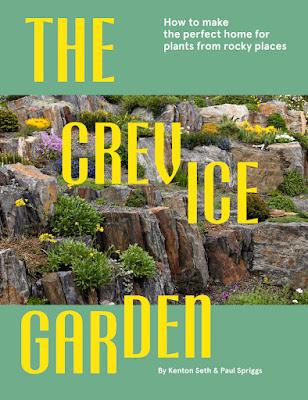As a child growing up in the 60s, a good rock garden was very much the thing to have. It was very trendy and every good garden would have one. A crevice garden is related being both the same and different. This new book talks us through the history of, the aesthetics and the building of crevice gardens.

I have not been paid to write this review and I have not paid for the book. My words and opinions are completely my own.
This is a fascinating book. It tells you everything you ever wanted to know about crevice gardens but never knew to ask. The key thing to know is that a crevice garden is trying to create the conditions that the plants of choice are used to in their native environment. The word crevice is vitally important, the principles involve using rocks and the graphics in the book show you how the plants grow to try and find soil and nutrients through layers of ground rock; or sand as is often used. Kenton and Paul explain the principles and give us diagrams so that we can understand what is needed and why. The book contains a very useful directory of plants that help decide which choices we want to make and can be planted in these gardens; including: alpines and ferns and conifers. Conifers, we are told, "are the stoic sentinels...."* of the crevice garden. Conifers were also very popular when I was growing up and it does feel like they are waiting patiently for their moment to return to popularity.
For me though this was not the really important message of the book. This book is about creating environments and environmental change. It is about adapting your gardening to the changing environmental conditions, about using waste materials and creating the ideal places for plants to thrive. I was very excited to see that the book talks about the garden of Peter Korn. I first heard of Peter at the Beth Chatto Symposium I attended way back in 2018. I was very taken with the ethos and the beauty of how Peter gardened and bought his book. I looked back at what I wrote at the time and it was summed up as 'sand is the answer'; in order to plant in hard conditions sand and grit are vital.
I finished the book inspired and wondering what I might be able to do to include a crevice moment in my garden. Of course you do not have to plant a full garden or indeed a border, you could just create a container. There is an example of a vertical crevice garden on page 78 by Harry Jans which is absolutely inspirational. The chapter 'Case Studies from the Best' is indeed just that. I defy anyone not to find at least one of the case studies a moment of wonder.
This is the book that alpine planters have been waiting for, this is also the book if you are not an alpine planter, you did not know you were waiting for. What is at first sight a niche (crevice??) part of the gardening world does not make it any less relevant to all our garden behaviours. As climate change rockets towards and engulfs us, an understanding of how to garden in different conditions is vital. This book gives us some exciting and innovative options.
The Crevice Garden by Kenton Seth and Paul Spriggs is published by Filbert Press.
Take care and be kind

